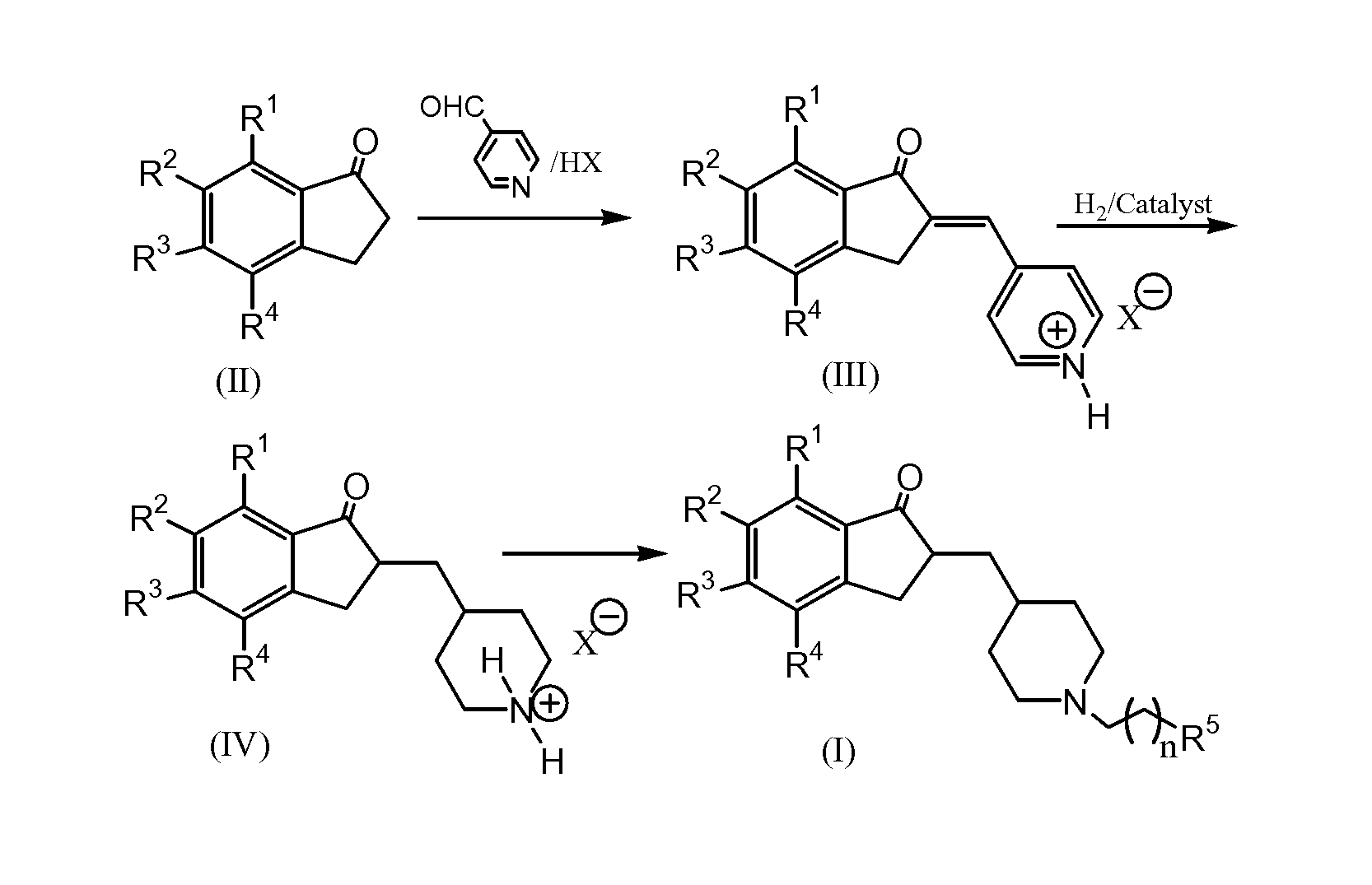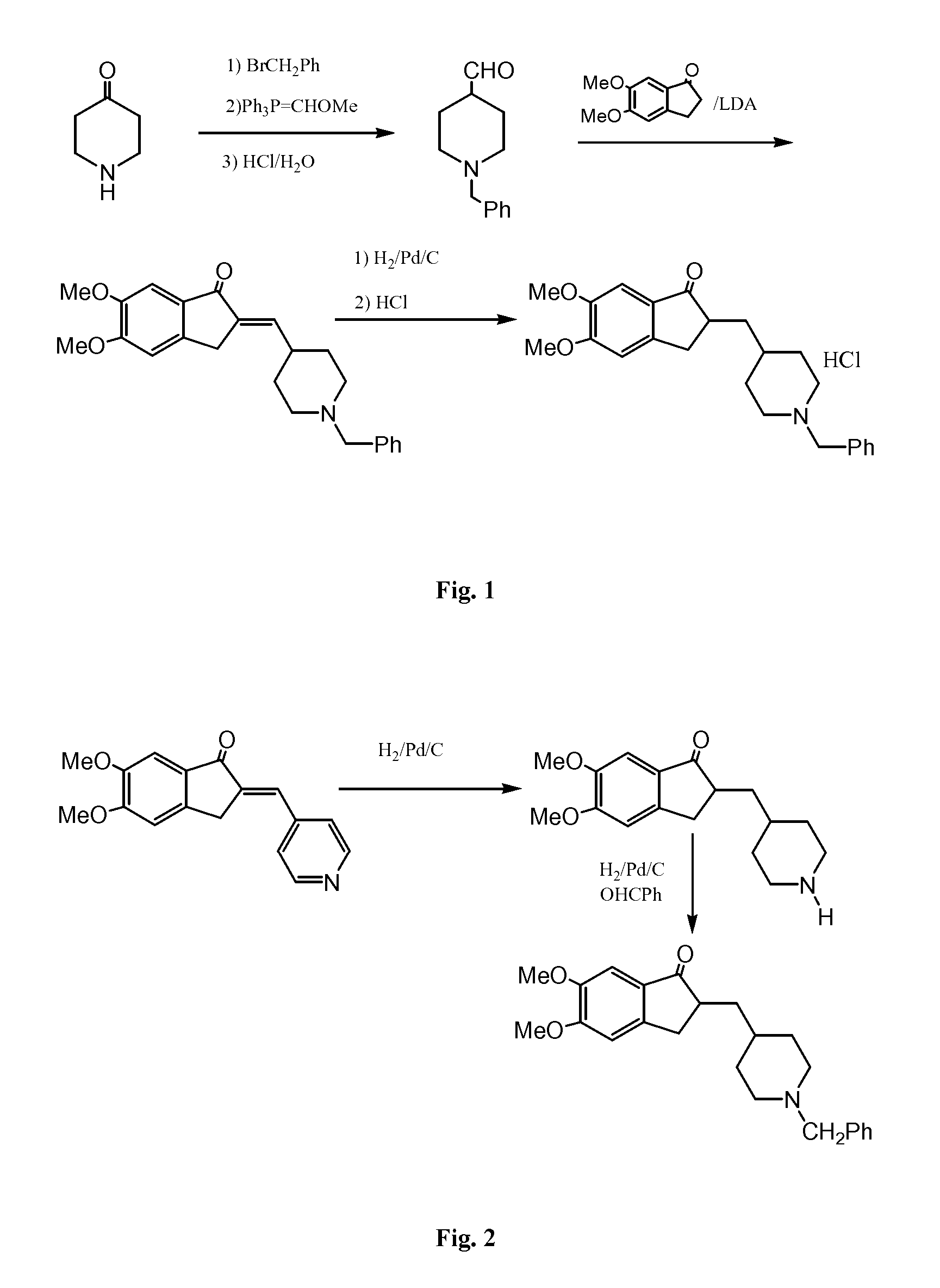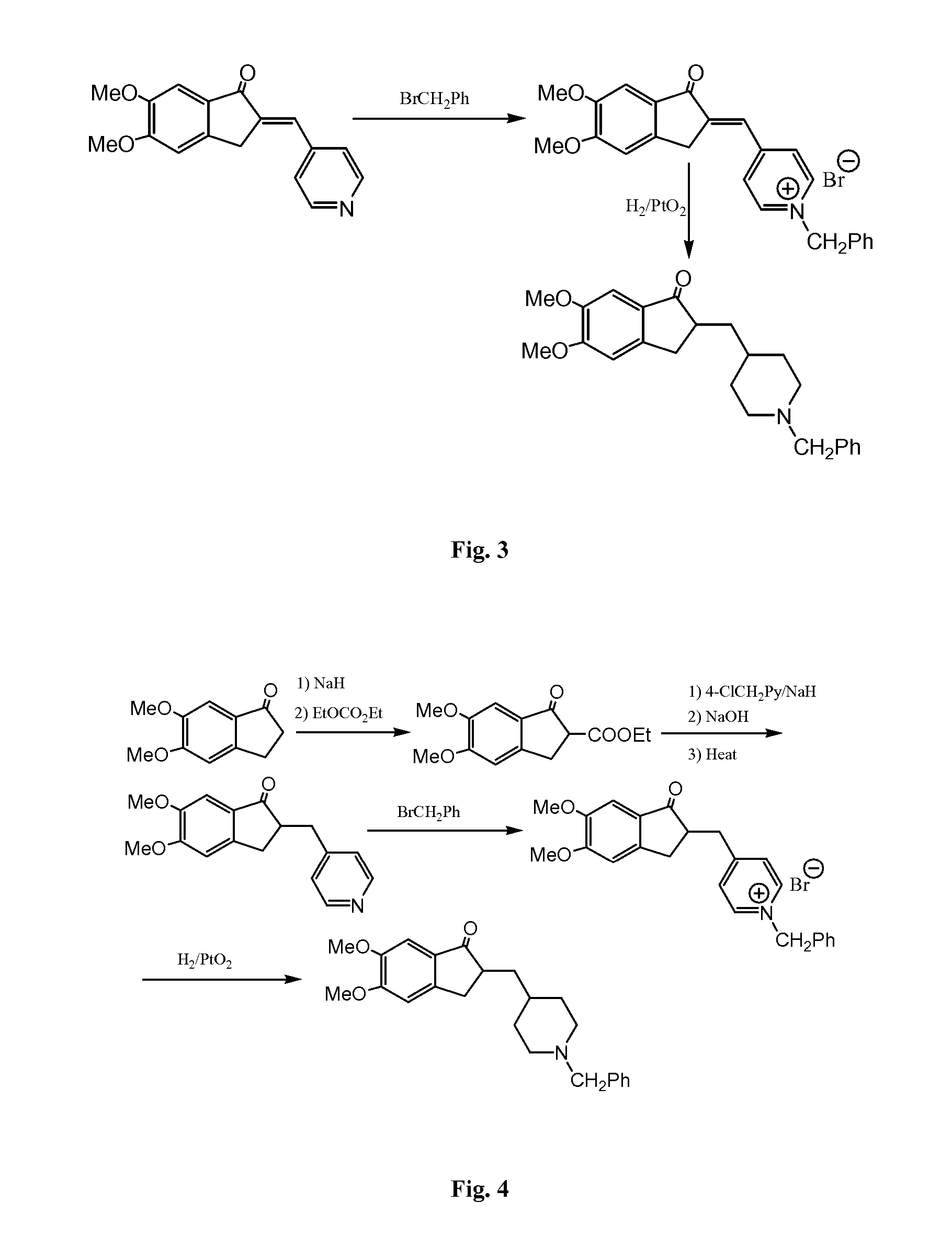Process for preparing Donepezil and its derivatives
a technology applied in the field of new synthesis of donepezil and derivatives thereof, can solve the problems of complex purification procedure, difficult reproducibility of process, complicated purification procedure, etc., and achieve easy operation and control, low cost, and mild reaction conditions
- Summary
- Abstract
- Description
- Claims
- Application Information
AI Technical Summary
Benefits of technology
Problems solved by technology
Method used
Image
Examples
example 1
2,3-dihydro-5,6-dimethoxy-2-((pyridin-4-yl)methylene)inden-1-one p-toluenesulfonic acid salt
[0046]0.96 g of 5,6-dimethoxy-1-indanone, and 0.75 g 4-pyridyl formaldehyde were added to a three-neck round bottom flask equipped with a Dean-Stark trap and an electromagnetic stirrer. 100 ml toluene was then added. Stirring continued until the reactants were dissolved. Then, 0.95 g of p-toluenesulfonic acid was added. The reaction was then carried out by refluxing for 12 hrs. After cooling, a solid was formed. The resultant solid was filtered off with suction affording 2.141 g of a yellow solid compound. The yield was 94%. 20 mL of anhydrous ethanol were added to the product, and the slurry was brought under reflux in ethanol for 30 minutes. After cooling at 5° C. for 2 hours, the resulting precipitate was filtered off with suction and after washing with 5 ml cold anhydrous ethanol and drying, 1.98 g of the title product were obtained. The melting point range was from 209-212° C. 1H NMR (DM...
example 2
2,3-dihydro-5,6-dimethoxy-2-((piperidin-4-yl)methyl)inden-1-one p-toluenesulfonic acid salt
[0047]0.402 g of 2,3-dihydro-5,6-dimethoxy-2-((pyridin-4-yl)methylene)inden-1-one p-toluenesulfonic salt were dissolved in 30 mL of methanol and 33 milligram of PtO2 were added. Stirring continued at room temperature, with H2 being supplied at 1 atmosphere for 7 hours. Solids filtered off with suction and washed with 5 ml anhydrous methanol. After concentrating the filtrate solid was obtained. To the solid 15 mL of anhydrous isopropanol was added. The mixture was heated to dissolve solids and then cooled to 0° C. overnight. The formed precipitate was filtered off with suction to afford 0.34 g of white crystalline solid. The melting point 191-192° C. After drying, additional 46 milligrams of solid were obtained. Liquid chromatography analysis showed product of 97% purity. A total of 0.386 g of the expected product was obtained at a yield of 94%. 1H NMR (DMSO-d6): 8.42 (br s, 1H), 8.18 (br s, 1H...
example 3
Synthesis of Donepezil (Method A)
[0048]0.18 g of 2,3-dihydro-5,6-dimethoxy-2-((piperidin-4-yl)methyl)inden-1-one p-toluenesulfonic acid salt were dissolved in 10 mL of dry N,N′-dimethylformamide. 0.073 g of benzyl bromide and 0.3 g of potassium carbonate were added thereto. The resulted mixture was stirred until the reaction completed. Then 60 mL of water were added and the solution was extracted with 4×30 mL of ethyl acetate. The extracts were combined, washed with 15 mL of Na2CO3 solution and with 15 mL NaCl solution, and dried over anhydrous MgSO4. Drying agent was then filtered off. The solvent was removed in vacuo yielding 0.141 g of product, 96% yield. 1H NMR (CDCl3), 7.15-7.35 (m, 5H), 7.09 (s, 1H), 6.78 (s, 1H), 3.89 (s, 3H), 3.84 (s, 3H), 3.48 (s, 2H), 3.17 (dd, 1H, J=8.0 Hz, J=17.6 Hz), 2.82-2.92 (m, 2H), 2.58-2.74 (m, 2H), 1.80-2.03 (m, 3H), 1.57-1.76 (m, 2H), 1.40-1.56 (m, 1H), 1.18-1.40 (m, 3H).
PUM
| Property | Measurement | Unit |
|---|---|---|
| pressure | aaaaa | aaaaa |
| pressure | aaaaa | aaaaa |
| temperature | aaaaa | aaaaa |
Abstract
Description
Claims
Application Information
 Login to View More
Login to View More - R&D
- Intellectual Property
- Life Sciences
- Materials
- Tech Scout
- Unparalleled Data Quality
- Higher Quality Content
- 60% Fewer Hallucinations
Browse by: Latest US Patents, China's latest patents, Technical Efficacy Thesaurus, Application Domain, Technology Topic, Popular Technical Reports.
© 2025 PatSnap. All rights reserved.Legal|Privacy policy|Modern Slavery Act Transparency Statement|Sitemap|About US| Contact US: help@patsnap.com



